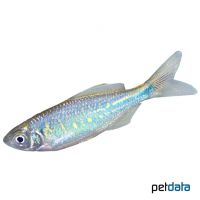Bengal Danio (Devario devario)
| Bengal Danio Devario devario | |
|---|---|
| Name | Bengal Danio |
| Name Lat. | Devario devario |
| Synonym | Danio devario |
| Family | Danios |
| Family lat. | Danionidae |
| Order | Carps |
| Order lat. | Cypriniformes |
| Origin | South Asia |
| Habitat | Forest streams, ponds |
| Diet | Omnivore |
| pH | 6.0-8.0 |
| Behavior | Peaceful |
| Keeping | Group |
| Care Level | Moderate |
| Reproduction | Egg scatterer |
| Breeding | Simple |
| Life Span | 5-9 years |
| Protection | No |
| Metric Units | |
| Size | 8-10 cm |
| Temperature | 15-26 °C |
| Hardness | 5-15 °dH |
| Aquarium | ~ 200 l |
| US Units | |
| Size | 3"-4" |
| Temperature | 59-79 °F |
| Hardness | 89-267 ppm |
| Aquarium | ~ 50 gal |
Distribution and habitat
The distribution area of the Devario Bearfish stretches from the north of India through Nepal to Bangladesh. They live mainly in shady, moderately flowing forest streams with a substrate of pebbles and stones, but also in ponds.
Maintenance
The aquarium should have a dense border planting, with hiding and retreat possibilities (roots, stones) and offer a lot of swimming space. A coarse, round gravel as substrate with some foliage covered (e.g. sea almond leaves), slightly shaded light (floating plants) and a weak current is ideal.
No ammonia, ammonium and nitrite should be detectable, the nitrate value should not exceed 100 mg/l. To ensure the water quality and oxygen content, a filter and heater adapted to the aquarium size is required, as well as lighting for the species-appropriate day-night rhythm of the animals.
Diet
In nature they feed on insects, small crustaceans, zooplankton and algae. The food offer consists of small live food, which is accepted without problems also in frozen form, supplemented with frozen food mixtures. Especially cyclops, daphnia and artemia must not be missing. In addition, they need regular vegetable food, such as pureed leafy and wild vegetables or dry food (flakes, granules) with high vegetable content (spirulina, kelp).
A regular and varied diet promotes health and increases resistance. Only feed as much as is eaten immediately (in a maximum of 10 minutes).
Behaviour and compatibility
They are swimming and lively fish, well suited for a community tank with other peaceful fish. In too small groups they remain shy and are aggressive within species. At least 5, but preferably much more Devario Beardlings should be kept together
In principle, only mutually compatible fish species with similar requirements to the water condition and water temperature may be socialized.
Sex dimorphism
Males are slimmer and more intensely colored, while females are larger and more plump.
Reproduction and breeding
They are free spawners and do not engage in brood care. The male usually swims around (drifts) the female in the early morning, which spawns among fine-feathered plants. The larvae hatch after 24-36 hours and swim freely after a few days.
Fry must be fed several times a day with special rearing food (dust food). In a community tank breeding is hardly possible, because the spawn is easy prey.
Important
The tank should be well covered, as they like to jump.
The well-being of the fish should be checked regularly. The temperature should be checked daily, the pH, hardness and nitrate value should be checked at least every 14 days. Regular partial water changes are recommended, even if the contaminant level has not yet reached the upper limit. Sudden changes in water quality should be avoided. Newly introduced fish must be accustomed slowly to the water in the aquarium.
Further literature can be found in your pet store.
References
Text: Sylvia Hos; Image: petdata
Source: BMELV (1998): Tierschutzgutachten - Haltung von Zierfischen (Süßwasser); RIEHL&BAENSCH (2007): Aquarien Atlas Bd. 1, Mergus Verlag; ENGELMANN (2005): Zootierhaltung - Tiere in menschlicher Obhut: Fische, Verlag Harri Deutsch
- Gemäß § 21 Abs. 5 Tierschutzgesetz idgF
